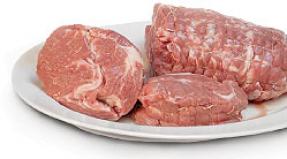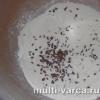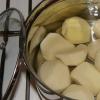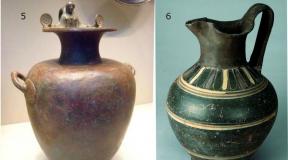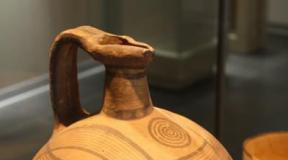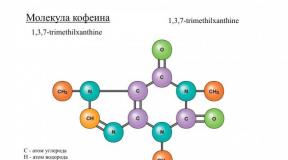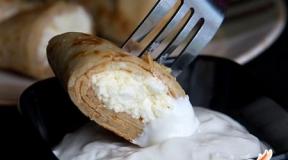Mint, useful properties and recipes. Benefits of mint for the human body: what to cook from mint to get the most out of this product
Hello dear gardeners! I have long wanted to ask: what do you do with mint, especially if there is a lot of it?
Everyone knows that peppermint is added to to give it a pleasant refreshing taste and aroma. This tea is good for colds: you can drink it hot or just breathe it in vapors. Soon, which means it is more relevant than ever. In general, it is, of course, a useful plant. But how else can you use it besides adding it to tea? Is this her only purpose?
As it turned out, no. It's just that we don't know about many of the uses of mint. And if we do know, then we neglect it. In vain ... Personally, after writing this post, my attitude towards mint has changed. So, let's get acquainted with mint goodies and usefulness)

Ingredients:
- Fresh mint - 30-40 g (5-6 branches).
- Vodka, cognac, moonshine or diluted alcohol - 1 liter.
- Water - 250 ml.
- Sugar - 350 g.
Sequencing:
- Put mint in a jar and pour alcohol over it. Close the jar with a lid and place in a cool dark place for 10-15 days. During this time, the liquid will turn greenish or bright green (the color depends on the quality of the mint). Strain the tincture through a sieve or cheesecloth, discard the mint.
- Dissolve sugar in boiling water and simmer, in other words, make a syrup. Then cool it down to room temperature.
- Add syrup to the tincture and mix well.
- Clean for a month in a cool, dark place. After the specified time, you can use it both in pure form and as part of cocktails. If the color has become somewhat brown, it's okay, it's because of the sugar.
Well, for children and non-drinkers ... This is what I first learned about. I'll try it today!

Ingredients:
- Fresh mint (with stems) - 300 g.
- Sugar - 3 tbsp. spoons (as many as possible, this is to your taste).
- Water (boiling water) - 2 l.
Sequencing:
- Put mint in a 2-liter jar (it will fill about 1/4 of the volume), cover with sugar and pour boiling water over it.
- Cover with a napkin and leave to infuse for 3 days at room temperature.
- After the specified time, remove the foam from above, strain the kvass and refrigerate. Drink, of course, chilled.

How to make mint ice cubes? Very simple! Chop the mint leaves and pour boiling water over them. Cover the container with a lid and wait until it cools completely. Then strain the infusion and freeze it in special molds. If you wish, you can put a mint leaf in each mold. It will be both fresh and beautiful =)
These are the ones. This must be not all that can be done with mint ... But, you must admit, this is a lot.
Mint is used for flavoring fruit gravies, frozen drinks, jellies, sauces, for flavoring vinegar, tea mixtures, bread kvass, confectionery, alcoholic beverages and tobacco products, fish products, for pickling cucumbers. When salting cabbage heads, mint provides long-term storage and gives cabbage excellent taste.
Adding mint to milk prevents sourness and increases shelf life. For flavor, mint is added to tomato juice and various fruit and vegetable salads. Fresh mint leaves improve the taste of roasted lamb, chicken, liver, lamb. It is added to stewed cabbage, carrots, leeks, peas.
In Europe, wines on mint were periodically insisted. And in Russia with mint they prepared a hot drink sbiten on honey. In the East, there are sorbets, refreshing drinks with ice, to which mint was also added. And in Europe, mint drinks grew thicker and finally became liqueurs, for example, the sugary emerald Cremedementhe. Summer cocktails with the addition of mint are also good, for example, the favorite by many "Mojito".
Fresh mint leaves are often used in cooking to decorate dishes, including sweet ones. In the culinary arts, mint is also used as a food coloring. Since fresh mint greens wilt very quickly, they need to be kept cool, preferably in the refrigerator. As a result of heat treatment, mint loses its freshness, therefore, it should be added to hot dishes immediately before serving.
There are quite a few types of mint, but only a few of them are widely used in cooking. The use of each of them has its own nuances.
Peppermint
Has a refreshing bitter taste. In cooking, it is used as a spice mainly only in the alcoholic beverage and confectionery industries, where they usually use not mint itself, but mint oil or mint essence.
At home, using peppermint in confectionery should be extremely careful, because if it overheats or exceeds the dose, it can ruin the whole business, imparting a bitter taste to the product. It is introduced into cookies, gingerbread cookies, buns, compotes, jelly, fruit drinks, liqueurs, and kvass. Not suitable for making tea because of its bitter taste.
Lemon mint (lemon balm)

Popular in European and Arabic cuisines. Finely chopped leaves added to summer salads make them healthier, more aromatic, and tastier. Dried herbs are added to vegetable, meat and fish salads in winter. Lemon balm goes well with game, veal, pork, lamb, fish. Vegetable, mushroom, dairy and egg dishes, as well as fruit, pea and potato soups, seasoned with lemon balm, acquire a delicate aroma.
The spice is used for canning cucumbers, to which it gives a pleasant smell and strength. In Moldovan cuisine, lemon balm is used in fresh filling or for pie.
Curly mint

It has no cooling taste, but has a wonderful refreshing aroma. It is widely used in home cooking, fresh and dried. Fresh mint leaves are added to salads, soups, especially vegetables. In the cuisine of some peoples, they are put as a seasoning in milk soups. Dried mint leaves are great for flavoring meats, pastries and baked goods, and sauces. In Ukrainian cuisine, it is added to fish and mushroom dishes. It is especially widely used in home canning of apples and vegetables (cucumbers, cabbage, carrots). Like some other types of mint, curly mint gives a wonderful aroma and taste to tea.
Apple mint

It has an extremely delicate aroma and taste that is not accompanied by refrigeration. It does not give bitterness at all when heated and increased in quantity, which radically differs from most other types of mint. Apple mint is used mainly in the cooking of the peoples of Transcaucasia and Central Asia. In Georgia, it is used to make sauces, in Armenia it is added to some varieties of cheese, in Central Asian countries it is used to improve the smell and taste of lamb dishes. It is also added to sweet dishes: compotes, jelly, jelly, preserves, apple pie fillings, and various confectionery products.
Spicy mint (Elsgolzia)

Dried buds and flowers collected at the very beginning of flowering are used as a spice. It has a subtle pleasant aroma reminiscent of lemon balm, but more spicy. Spicy mint is added mainly to minced meat, pates from offal, homemade sausages, used when stewing lumpy meat, as well as for flavoring, snacks, sandwiches and soups. The dosage when added to minced meat can be quite significant, since elsholtia gives almost no bitterness when heated. Like marjoram, spicy mint has an ennobling effect on the texture of the meat.
Mint is one of the most widespread spices in the cuisine of nations around the world. Dried or fresh mint leaves are used in a wide variety of food and home cooking applications. It is especially widely used in oriental cuisine, and not only as an excellent spice, suitable for a variety of products. Fresh mint leaves are often used in cooking to decorate dishes, including sweet ones. In the culinary arts, mint is also used as a food coloring. Since fresh mint greens wilt very quickly, they need to be kept cool, preferably in the refrigerator. As a result of heat treatment, mint loses its freshness, therefore, it should be added to hot dishes immediately before serving.
Peppermint in cooking
In industrial production, essential oil and menthol are obtained from peppermint, which has a refreshing, cooling taste.
These ingredients are widely used to flavor various beverages in the alcoholic beverage industry. Peppermint oil is also widely used in the production of confectionery.
In home cooking, both fresh and dried leaves of the plant are used. Fresh mint is often added to savory lamb and poultry dishes.
Dry ground mint is widely used in the manufacture of a wide variety of flour products, especially in baked goods (rolls, pies, pies, pastries). Culinary experts from many European countries add peppermint as a seasoning to various vegetables (tomatoes, cucumbers, potatoes, cabbage, carrots) and legumes. It is used to enhance the taste and smell of a variety of sauces.
From ancient times to the present day, peppermint has been an indispensable ingredient in the manufacture of refreshing and soft drinks, especially summer drinks.
It is added to fruit drinks, compotes, jelly, syrups. Tea with mint is especially popular with many peoples, which is not only very tasty, but also extremely useful.
Peppermint is usually used on its own and is not combined with other spices. Dosing it, like many other spices, should be minimal. The average rate of fresh mint is from 1 to 5 g, dried 0.2 to 0.5 g per serving. Put mint in dishes 5 - 10 minutes until cooked.
Field mint in cooking
Unlike peppermint, field mint has no pungent smell and cooling taste.
As with other types of mint, leaves (raw and dried) and flower buds are used as a spice.
Fresh field mint is an excellent vitamin and flavor additive to summer salads. Leaves in whole or chopped form are laid in vegetable soups, fish dishes.
It is also widely used in the preparation of dough products. Field mint not only improves the taste of products, but also helps to increase their shelf life, so it is widely used in canning vegetables, especially cabbage.
For this reason, field mint leaves are added to kvass, which, acquiring a very pleasant taste, in addition, are stored much longer. Mint is widely used in the preparation of drinks with a tonic effect. For many European peoples, field mint completely replaces tea or serves as an addition to other teas.
Long-leaved mint in cooking
Long-leaved mint is used in different national cuisines to flavor second courses of meat and fish, as well as dough products (pies, gingerbread, flat cakes, etc.). In some countries, it is used as an additive in cheese making. It is also used to improve the taste and aroma of beverages (kvass, compotes, fruit drinks, pans). In home canning, this type of mint is added to marinades when pickling and pickling various vegetables, especially in pickling.
Curly mint in cooking
Curly mint does not have a cooling taste, but it has a wonderful refreshing aroma. It is widely used in home cooking, fresh and dried.
Fresh mint leaves are added to salads, soups, especially vegetables.
In the cuisine of some peoples, they are put as a seasoning in milk soups.
Dried mint leaves are great for flavoring meats, pastries and baked goods, and sauces. In Ukrainian cuisine, it is added to fish and mushroom dishes.
Especially widely in Eastern European countries and in Russia, this spice is used in home canning of apples and vegetables (cucumbers, cabbage, carrots).
Like other types of mint, curly mint gives a wonderful aroma and taste to tea.
Apple mint in cooking
Apple mint is used mainly in the cooking of the peoples of Transcaucasia and Central Asia. In Georgia, it is used to make sauces, in Armenia it is added to some varieties of cheese, in Central Asian countries it is used to improve the smell and taste of lamb dishes.
Spicy mint in cooking
Spicy mint Spicy mint differs in that it does not give bitterness. Fresh mint is added to salads and sandwiches. Dry powder from its leaves is flavored with soups, meat dishes, minced meat and pates (especially those made from offal), sausages.
The norms for the use of this spice depend on the desire. Even in large doses, it does not spoil the taste and aroma of dishes.
Mint, including peppermint, is a very common spice plant that is actively used in cooking and not only. It is a very undemanding plant and often grows like a weed in home gardens. You can grow it in a flower pot on the windowsill and always have this wonderful spice at hand. This culture is unpretentious and at the same time very, very useful. In cooking, mint leaves are mainly used.
Properties and benefits of mint
The properties and useful properties of mint are largely determined by its composition, the content of natural menthol in its leaves.
Peppermint tends to calm our body and help improve its digestion. Brew mint tea or add mint leaves to your favorite tea for a good drink. The benefits of such a simple drink are wide - it gives the body a calming effect, improves blood circulation, relieves us of headaches. Peppermint tea will relieve nausea and improve digestion. Mint tea can also help you relax, relieve insomnia and irritation. Here's how much we benefit from just one cup of mint tea. By the way, few people get bored with tea brewed on mint leaves.
Using mint
Now, more than ever, we actively use many herbs in cooking, including mint itself. Mint always adds a touch of piquancy to the dish. For example, in such a dish as leg of lamb with mint sauce, sauce plays an important role.
In order not to lose all the beneficial properties of mint, you need to add it to the prepared dish for a certain time before it is ready. Otherwise, it will spoil the taste of this dish, the pleasant mint taste can become simply bitter.
In many cold drinks and dishes, you need to add it in advance so that the essential oils of mint are transferred, for example, into such an interesting drink as mint kvass.
Peppermint is often used in various dishes. They add it to poultry, meat, vegetables, fish dishes, to many salads and desserts. Mint is used in the preparation of drinks and sauces.
It gives confectionery and baked goods an unusually pleasant aroma, just remember the mint gingerbread. The essential oils contained in mint have a pleasant aroma, fresh and refined taste. Mint dishes can help boost your mood.
You can also use mint leaves to decorate desserts, salads, main courses.
Peppermint perfectly aromas vinegar and vegetable oil. It is enough just to add mint sprigs along with other herbs to bottles with vinegar or oil, let them stand in a dark place for about one or 2 weeks, and then use them with pleasure.
Peppermint can also be used in some marinades for fish, meat and poultry. Such marinades always carry a touch of freshness and marinade and meat, in which they give the pickled a piquant taste.
It is appropriate to use mint, both fresh and dry.
Peppermint can be consumed alone or mixed with other herbs. For example, it takes pride of place in the composition of hops-suneli, where mint goes well with all the herbs that make up the composition and perfectly complements this mixture.
Let's take a look at a few different options from the huge list of peppermint uses in cooking. Let's start with a green fish marinade.
Green marinade for fish
- Peppermint - one bunch
- Cilantro - one bunch,
- Shallots - three pieces,
- Small lemon or lime - one piece,
- Peanut butter - 150 grams,
- Salt.
Rinse cilantro, mint, onion - lemon and shallots thoroughly under running water, then dry.Finely chop the cilantro and mint. Peel and chop the shallots. Rub the lemon zest on a grater. Squeeze the juice out of the lemon. Combine everything together with peanut butter and salt in a bowl, mix well. So, our fish marinade is completely ready. This marinade can be used to marinate fish for grilling, barbecue, or for frying on the stove.
Mint sauce for baked meat
- Mint leaves - 15 g
- Sugar sand - one tbsp. a spoon,
- Shallots - one piece,
- Wine vinegar - three to four tablespoons,
- A pinch of salt.
Combine wine vinegar (you can take any white or red to taste), granulated sugar and salt in a bowl, stir so that the granulated sugar dissolves. Sufficiently chop the onion and mint, add to the sugar and vinegar, mix it all. Pour the mixture into a gravy boat. Mint sauce goes especially well with baked lamb.
You can speed up the preparation of this sauce by making it larger and using a blender to chop it.
Mint salad
- Mint - one small bunch,
- Fresh cucumber - two pcs.,
- Bovine heart tomatoes - one or two,
- Onion chives - half a small bunch,
- Garlic - a couple of cloves
- Lemon juice - two tablespoons
- Grape seed oil - two spoons,
- A mixture of peppers and salt.
Cut the tomato crosswise and scald with boiling water, remove the skin. You can remove the seeds if you wish. Cut the tomato into medium cubes. Put it all in a bowl.
Peel the cucumbers, if necessary, from the skin, seeds and cut into medium cubes, add to the tomato cubes in a bowl.
Schnitt - Chop the onion and add it to the vegetables in our bowl. Separate the mint leaves from the twigs, put them together in a pile and chop them. Then rub a little in your hands and add to the bowl with the other ingredients of our salad.
Peel the garlic, chop it finely and grind it together with salt and a mixture of different peppers in a mortar. Add grape seed oil and lemon juice to the crushed garlic. Mix everything well. Pour the dressing into a bowl of our salad. We mix. You can skillfully decorate the salad with mint leaves.
Non alcoholic mojito
- One bunch of mint
- Lime - one piece,
- Cane sugar - a couple of tablespoons
- Ice - two glasses
- Mineral water - bottle.
Separate the mint leaves from the branches. Cut the lime into eight slices.
In a couple of tall glasses we place about twenty to twenty-five mint leaves, 1 tablespoon of cane sugar each and knead (for example, using a pestle for a mortar). Gently grind the mint leaves with sugar to get a stronger mint aroma and taste. Squeeze the juice from 4 lime slices into each glass and put these slices there. Fill a glass with ice cubes and fill it all with mineral water. Serve soft drink with cocktail tubes.
Mint tea
- Mint - one tablespoon
- Leaves from black currant - one tbsp. a spoon,
- Lemon zest - a pinch
- Water - about 500 ml.
Put dry leaves from black currant together with dry mint and lemon zest in a glass teapot, which we rinse with hot water beforehand. Boil the water, cool it a little, to 90 - 95 degrees, and fill the kettle by half, let it brew for two minutes, and fill it with the remaining water. If you eat dry black currant berries, you can also add them to the kettle,
2013 -10-20 16:23
| align = right> |
Mint(lat. Mentha) - a genus of plants Lamiaceae or Labiatae - the most aromatic spice with the smell and taste of menthol, used since ancient times to freshen the breath.
Cooking spice mint
Mint leaves, which give dishes a refreshing taste and aroma, are popular as a spice among culinary specialists around the world.
There are many varieties of mint, the most popular is peppermint (Mentha piperita), which has the best composition of nutrients with an ideal mint taste and smell.
The use of mint in tea is well known - the spice imparts many beneficial properties to the drink, making it refreshing.

Fresh mint, as a greenery, is added to vegetable and meat salads. Popular uses of mint in fruit salads. And also in desserts - from mint ice cream and sorbet, to a fresh mint leaf that crowns absolutely any sweet dish.

The mint spice is used in first courses - it is used to season vegetable, meat, chicken soups and broths.

In many countries, mint is used to prepare lamb and beef meat dishes.

The combination of mint with melon and smoked meat has been known for a long time.

Mint sauces for almost any dish are a hit in English cuisine. Also, the British love mint chocolate.
Mint is often added to cheeses and cottage cheese dishes.
Mint spice is an excellent ingredient in cake fillings.
Mint can be found in pickled eggplants, sauerkraut, and preserves.
In modern cuisine, mint can be found even in fish dishes.
Traditionally, in Russian cuisine, mint is used in kvass, sbitnya, mead, gingerbread, and candies. It is still believed that adding mint leaves to fresh milk prevents milk souring.
In Uzbekistan, fresh mint is used in salads; dough for flat cakes is prepared on its infusion.
Mint is a favorite of culinary specialists in sweet drinks: compotes, fruit drinks, juleps, liqueurs, liqueurs, crochets, mojitos ...

In oriental cuisine, mint is also very popular. For example, it can be used as a side dish mixed with other herbs or vegetables. Mint is found among other herbs for the Jewish Passover lamb. Or served with yogurt, herbs, cucumbers.
In southern European countries, mint is often combined with dough and cheese (pasta, cheese).
Mint is found in spice mixtures: baharat, ducca, curry, Moroccan, fine herbs, Provence herbs, suneli hops, shichimi.
Fresh mint is best, but can be dried and stored in a tightly sealed glass container in a dark place.
Medicinal uses of the spice mint
Mint has been loved by the Aesculapians for a long time. Not surprisingly - thanks to the substances it contains (essential oil of mint: menthol, menton, lina-lool, carvone, limonene, cineole, citral, pulegon, flavonoids, tannins, bitterness, etc.), mint fights many ailments.

Everyone is familiar with the antiseptic effect of mint toothpastes and chewing gums on the oral cavity since childhood.
Mint decoctions and teas have long been used to fight colds and coughs.
Medicines based on mint normalize cardiac activity, improve blood circulation in the brain; are used to improve digestion, as sweat and choleretic, sedative, anti-inflammatory, analgesic.
Mint infusion is used externally to relieve pain in rheumatism and arthritis. Mint is a sedative for nervous disorders and depression. Also, mint has a general strengthening effect.
The scent of mint increases concentration.
Mint preparations have contraindications (small children, pregnancy, some diseases), so you should consult your doctor.
Description of the spice mint
Mint (lat. Mentha) - a genus of plants Lamiaceae or Labiatae - the most aromatic spice with the smell and taste of menthol, used since ancient times to flavor breath. This genus has more than 25 species and 10 hybrids, they differ in chemical composition, therefore they have a different composition of essential oils and smell.
The most common types of mint are: peppermint, curly, long-leaved, field mint, flea mint.
Lemon mint actually does not belong to the genus of mint: it is a plant from the genus Melissa - Melissa officinalis. The so-called Vietnamese mint does not refer to peppermint or its relatives, but to Vietnamese coriander.
Mint is also called perekop, bezhava, dragolyub, mint, mint, narpiz, jalbus-aryk.
Leaves and young shoots are used as spices; has a pleasant, delicate, refreshing scent and a slightly pungent taste.
However, there are many hybrid varieties of cultivated mint, the smell of which has little in common with the traditional mint scent - orange, cologne, bergamot-like, apple, ginger, pineapple. These plants are used as additives to tea, not for culinary purposes, but brave chefs can try them in cooking too.
This plant is easy to grow in your country house and even at home, in almost any land.
Mint in the wild is widespread in Europe and Asia Minor, in central and southern Russia, in the Caucasus, in Western Siberia, in Ukraine, North Africa, and in the temperate zone of the Americas.
Good lighting is essential for mint. The raw materials for the collection are grass and leaves. Mint is harvested during the period of maximum essential oil content in plants - before flowering. In dry weather, mint dries in the field in 5 days or in dryers with good ventilation, then threshing is carried out. Essential oil is obtained from raw materials, the leaf is sold through pharmacies or as a spice.
History of the spice mint
The name of the mint genus comes from the name of the ancient Greek goddess Mint (Mina), the mistress of Mount Mente, in which the god of the underworld Hades inadvertently fell in love. Hades' wife Persephone turned Minta into a herb, and Hades endowed the plant with a delicate and fresh scent.
The birthplace of mint is Asia Minor. We find references to the spicy-aromatic plant mint in the Gospel of Matthew, as well as in the tombs of the pharaohs and on the Assyrian cuneiform tablets.
The ancient Greeks and Romans believed that the smell of mint refreshes not only the breath, but also the mind - scientists wore mint wreaths on their heads. The floors and tables were rubbed with mint leaves to improve the smell in the rooms, create a good mood and show guests that they are welcome.
The soldiers were forbidden to use mint for food during the service - it was considered an aphrodisiac.
The Greek "minthe" became the Latin name "mentha". In Russian, it began to sound "mint".
In Russia, they loved "perfumed" cabbage soup with mint. On Trinity, they wondered for the other half, putting a leaf of fresh mint under the pillow.


